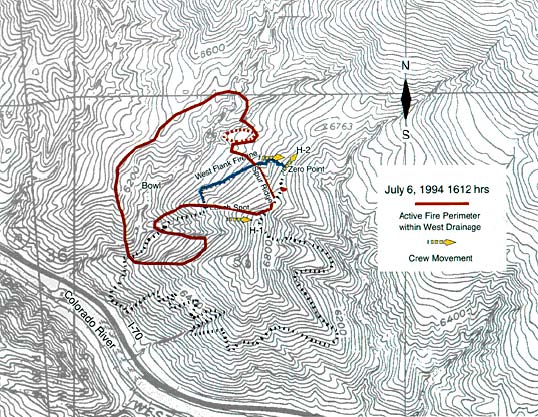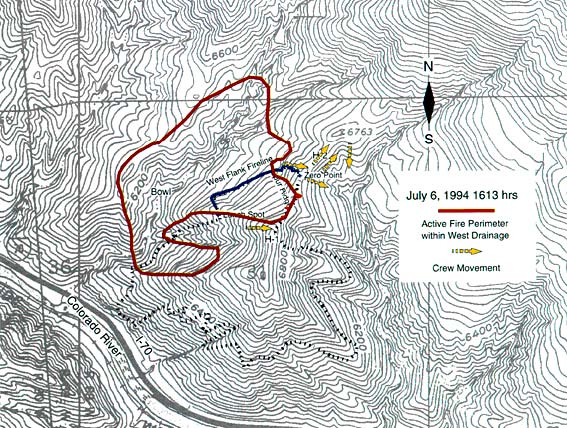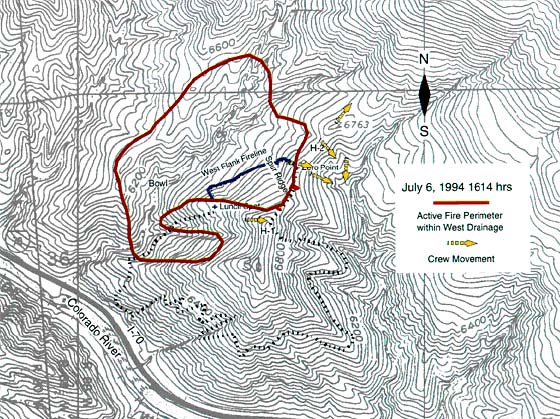
 South
Canyon Fire South
Canyon Fire
1994
6 Minutes for Safety — 2009
Fire Behavior Report, 1998
Fire Environment
- July 2 to
Evening of July 5
- July
5, 2230 to July 6, 1530
- July 6, 1530
to 1600
- July 6, 1600
to 1603
- July
6, 1603 to 1609
- July 6, 1609
to 1610
- July 6, 1610
to 1611
- July 6, 1611
to 1614
- July 6, 1614
to 1623
- July
6, 1622 to 1830
- July
6, 1830 to July 11
References
Appendix A
Appendix B
Appendix C
|
 Fire
Behavior Associated with the 1994 South Canyon Fire on Storm King Mountain,
Colorado Fire
Behavior Associated with the 1994 South Canyon Fire on Storm King Mountain,
Colorado
Fire Chronology (continued)
July 6, 1611 to 1614—Firefighters on West Flank Fireline Overrun
Main Ridge—As they retreated north along the ridge,
the Main Ridge Group passed through active spot fires burning along the
Main Ridge Fireline. Several of the firefighters later stated that fire
was burning on both sides of the ridge (South Canyon Report). Some indication
of the severity of the situation is indicated by the fact that they abandoned
the chainsaw fuel containers on both sides of the trail. The main fire
was producing a loud roar (South Canyon Report). Hotshot Scholz said that
they felt that the fire was moving north at a pace equal to theirs (Scholz
1995). As they passed the Zero Point, the air contained burning embers
and smoke. Hotshot Navarro, who was near the back of the group, said that
when he neared the Zero Point, “The fire was only on my left or
west” (South Canyon Report). At this time, Scholz and some of the
other firefighters dropped off the east side of the Main Ridge and followed
a trail that contoured along the side of the ridge toward H-2. Some firefighters
recall hearing chainsaw fuel containers exploding behind them.

Figure 30—Fire perimeter at 1612. Fire is 400 ft south and 450 ft
southwest of firefighters on West Flank Fireline. Main Fire has merged
with spot fire and is burning up slope north of fireline. Concave shaped
fire front begins to form around top (northeast) section of West Flank
Fireline.
After leaving the Photo Point, Archuleta moved south toward the Zero
Point to make sure that none of the firefighters in the Main Ridge Group
turned down the West Flank Fireline. As the last of the Main Ridge Group
firefighters passed him heading toward H-2, Archuleta also started toward
H-2 (about 1612) (South Canyon Report). About 80 feet north of the Zero
Point, Scholz looked back to the south along the ridge and saw the fire
curling over the Main Ridge behind a firefighter running down the trail
toward him (Scholz 1995). The fire burning up the slope behind the Spur
Ridge had crested the Main Ridge 200 feet south of the Zero Point.
Main Ridge Near H-2—Robertson, Archuleta, and
Ryerson remained on the Main Ridge. Ryerson, who was ahead of Archuleta
and Robertson, stated that as she neared H-2 there was heat, intense smoke,
and sparks everywhere, and the fire was close on the west side (South
Canyon Report ; Good 1996; OSHA 1995). As they moved along the Main Ridge
toward H-2, Robertson and Archuleta could feel heat behind and to their
left. The remaining chainsaws and fuel containers were abandoned north
of H-2. The firefighters were told to go down into the East Drainage.
Zero Point—Shortly after the last of the Main
Ridge Group passed the Zero Point, BLM Firefighter Haugh, reached the
top of the West Flank Fireline and continued a short distance over the
ridge into the East Drainage. The heat was intense enough that Haugh received
some first-degree burns (Husari 1996). Smokejumper Erickson, who followed
shortly behind Haugh, received second-degree burns to his upper back,
neck, and elbows (Hospital Report 1994).
West Flank Fireline—Based on our reconstruction
of crew and fire movement and interviews with witnesses, we estimate that
Jumpers Thrash and Roth stopped near the Tree about the time Haugh and
then Erickson reached the Zero Point. The rest of the West Flank Fireline
group following in a line behind them stopped. We estimate that after
a short hesitation, Hotshot Blecha stepped around the group, and continued
up the hill. Our timeline places Hipke about 45 seconds behind Erickson.
We estimate that Blecha followed about 40 seconds (100 feet) behind Hipke.
H-2 and the East Drainage—Helicopter Pilot Good
returned and hovered about 100 feet above and northeast of H-2 (between
1612 and 1613). He estimated his return time after dropping the water
bucket at the subdivision to be 5 to 7 minutes (Good 1996; Hopf 1996;
South Canyon Report). The pilot saw people running north along the Main
Ridge and then moving off the ridge from a point south of H-2 down into
the East Drainage. The pilot was unable to make radio contact with any
of the firefighters. Winds were from the west and blowing harder than
when the pilot had made the previous water drop on the Main Ridge. Grit
and debris were blowing through the open cockpit doors. He could see fire
burning along the top of the Main Ridge from H-1 to the intersection of
the Spur Ridge and the Main Ridge. Flames were 150 to 200 feet high. Fire
was burning 100 to 200 feet below (west) H-2. Fire had progressed north
up the West Drainage and was spreading east toward the Saddle (Good 1996;
OSHA 1995).
As the first members of the Main Ridge Group began descending into the
East Drainage, Shepard, Blanco, and Helitack Crewmembers Tyler and Browning
moved some red packs that had been left north of H-2 to a small depression
nearer the helispot (approximately 1613). Shepard estimated that they
only looked down for 20 seconds but were surprised when they looked up
from moving the packs to find that the fire was nearly to H-2 (Shepard
1995). Smoke and burning embers were flying into the area and fusees with
the gear at H-2 were igniting (Shepard 1995).
West Flank Fireline—Using all of the available
information, our best estimate of the fire location between 1612 and 1613
is shown in figures 30 and 31. Fire was burning upcanyon and upslope as
a continuous front that stretched from the Rocks to the junction of the
Main Ridge and the Spur Ridge then down the Spur Ridge across the north
end of the bench and partially up the slope toward the Photo Point and
H-2.
The fire burned quickly up the hill. Prineville Hotshot Scott Blecha
died 120 feet from the top of the fireline. Prineville Hotshot Crewmembers
Kathi Beck, Tami Bickett, Levi Brinkley, Doug Dunbar, Terri Hagen, Bonnie
Holtby, Rob Johnson, and Jon Kelso; and Smokejumpers Don Mackey, Roger
Roth, and James Thrash were entrapped and died 200 to 280 feet below the
Zero Point.

Figure 31—Fire perimeter at 1613. Fire is burning on three sides
of the last section of the West Flank Fireline.
While Hipke hiked up the last section of the fireline he felt his arms
and neck getting hot. He dropped his pulaski, which was later found 82
feet below the Zero Point, and tried to remove his fire shelter to use
as a shield. Hot air and embers blew past him. He could feel his ears
getting burned and it seemed to be getting hotter. His hardhat was on
backwards, and the bill provided some protection to the back of his neck
while he used his hands to shield his ears and face from the increasingly
unbearable heat. He had difficulty getting the shelter out of its wrapper
and dropped it 15 feet from the Zero Point when he tried to leap forward
to escape the heat. As he jumped forward, hot air hit him forcibly from
behind and he fell forward to the ground, yelling as he fell and catching
his fall with his hands (estimated time 1614). After falling forward,
he jumped back up and hiked across the top of the ridge, shielding his
face and ears from the heat with his hands. Hipke, though burned on both
sides, did not recall seeing fire as he hiked over the top of the Main
Ridge. Figure 32 shows the location of the fire at this time. The shoulder
straps on Hipke’s backpack had melted or fallen off, leaving the
pack hanging by its belt strap and bumping against the backs of his thighs
(Hipke 1994). Reaching the east edge of the Main Ridge he unsnapped the
backpack belt strap, left the pack, and ran down the steep slope into
the East Drainage. Hipke suffered third-degree burns over 10 percent of
his body including his hands, arms and elbows, buttocks, thighs, calves,
right shoulder, face, and back of his head. He received lesser burns on
his left side (Hospital Report 1994). A few hundred feet down the slope
Hipke met Haugh and Erickson who wrapped the burned portion of his arms
and hands in a T-shirt and poured water over the makeshift bandage. Together
they moved down the East Drainage. They were the first firefighters to
reach the Interstate highway (Hipke 1995).

Figure 32—Estimated fire position at 1614. Fire had reached Main
Ridge from H-1 to Zero Point and was approaching H-2. Some firefighters
were entering the East Drainage.
<<< continue
reading—Fire Behavior at South Canyon Fire, Fire Chronology: July
6, 1614 >>>
|
